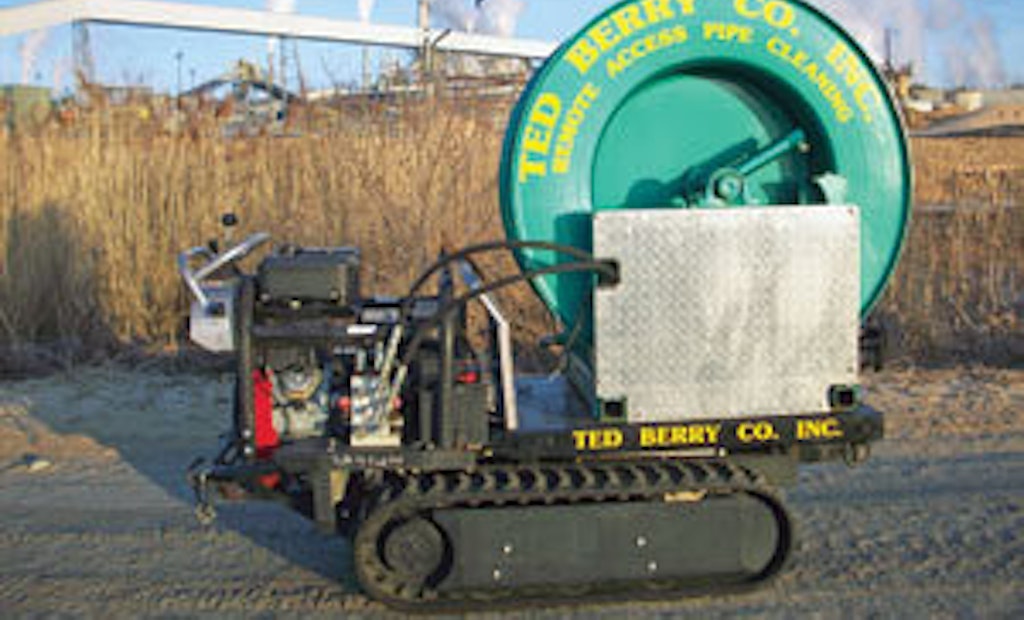Interested in Plumbing?
Get Plumbing articles, news and videos right in your inbox! Sign up now.
Plumbing + Get AlertsGetting access to remote sewer interceptors that run along riverbanks in Maine used to be a real chore for workers at Ted Berry Co. Inc. in Livermore. That changed when the company bought an easement jetter with a 600-foot hose reel.
“For a combination truck to access these easements, which typically aren’t very well maintained, we’d have to build a gravel road,” says Matt Timberlake, vice president. “We did a job years ago with 12- and 14-inch oak trees growing in the easement. After that, we looked hard at how to approach these jobs faster and with less impact.”
Timberlake’s research turned up the TracHorse all-terrain carrier from Stanley Hydraulic Tools, a division of The Stanley Works. A self-propelled, compact carrier with 1,000-pound load capacity, the unit comes with a gasoline or diesel engine and uses hydraulic-powered rubber tracks to transport material and equipment. It runs a variety of tools that require water at up to 10 gpm/2,000 psi, supplied by a combination truck or a large waterjetter.
Easy to operate
The company bought its first TracHorse unit several years ago and recently bought another. It measures 80 inches long and 32 inches wide, can turn 360 degrees within its own length, and can traverse grades up to 60 percent. It has electric start, a top speed of 2 mph, a hydraulic-powered tilt bed, removable sides for flatbed use, and deadman control valves.
The operator walks behind the machine and operates it with two hand-control levers. “It’s very similar to driving a skid-steer,” Timberlake says. “On our older unit, we rigged a platform that the operator can stand on while driving.”
While tiny compared to a combination truck, the machine delivers high productivity. Besides simplifying easement access, its maneuverability in tight industrial spots is a plus. “We have an industrial service division that does annual sewer cleanings at pulp and paper mills and hydroelectric plants,” Timberlake says.
“We get maybe a 24- or 36-hour window, and the less time we spend trying to negotiate a big truck to a specific manhole, the better. The time saved varies, but it might take three hours to set up with a traditional truck, compared to half an hour with the TracHorse. With a 24-hour plant outage, every half-hour is extremely valuable.
“The machine is also much less intrusive to other contractors. We can set our big truck farther away from the work area and allow other contractors easier access.”
Big cleaning jobs
To clean multi-million-gallon clarifiers for compliance inspections at wastewater treatment plants, crews remove the reel. That takes about five minutes, thanks to four independent jacks, one on each corner of the bed. Then workers attach a “deck gun,” similar to a fire truck’s water cannon. The pressure required to clean the clarifiers with a hose could easily “blow a guy over backwards,” Timberlake says.
“When I first got out of high school, I was on one of these clarifier jobs,” he recalls. “We worked about 36 hours around the clock. The last one we did with a TracHorse took two guys about four hours.”
Crews typically use the machine to tow the water-supply hose out to the work site, where it’s connected to the hose on the reel. To make up for pressure lost along the hose run, crews typically use a 1 1/4-inch supply hose and connect it to a 1-inch hose on the reel to do the actual jetting.
“The truck might read 2,000 psi, but we might have only 500 at the tip,” Timberlake says. “We figure out how much tip pressure we want and work backwards from there. It’s easy to calculate the pressure drop.”
The company is fabricating a custom reel that will hold 800 feet of 1 1/4-inch hose. That will enable crews to clean even larger remote-access lines and municipal and industrial outfall pipes. Renting a barge to float a combination truck to a remote outfall pipe can cost $20,000 to $30,000 a week. A barge large enough to hold a TracHorse costs about $1,500 a week.
“They’re extremely valuable machines,” Timberlake says. “They’ve become such an important accessory to what we do.”







